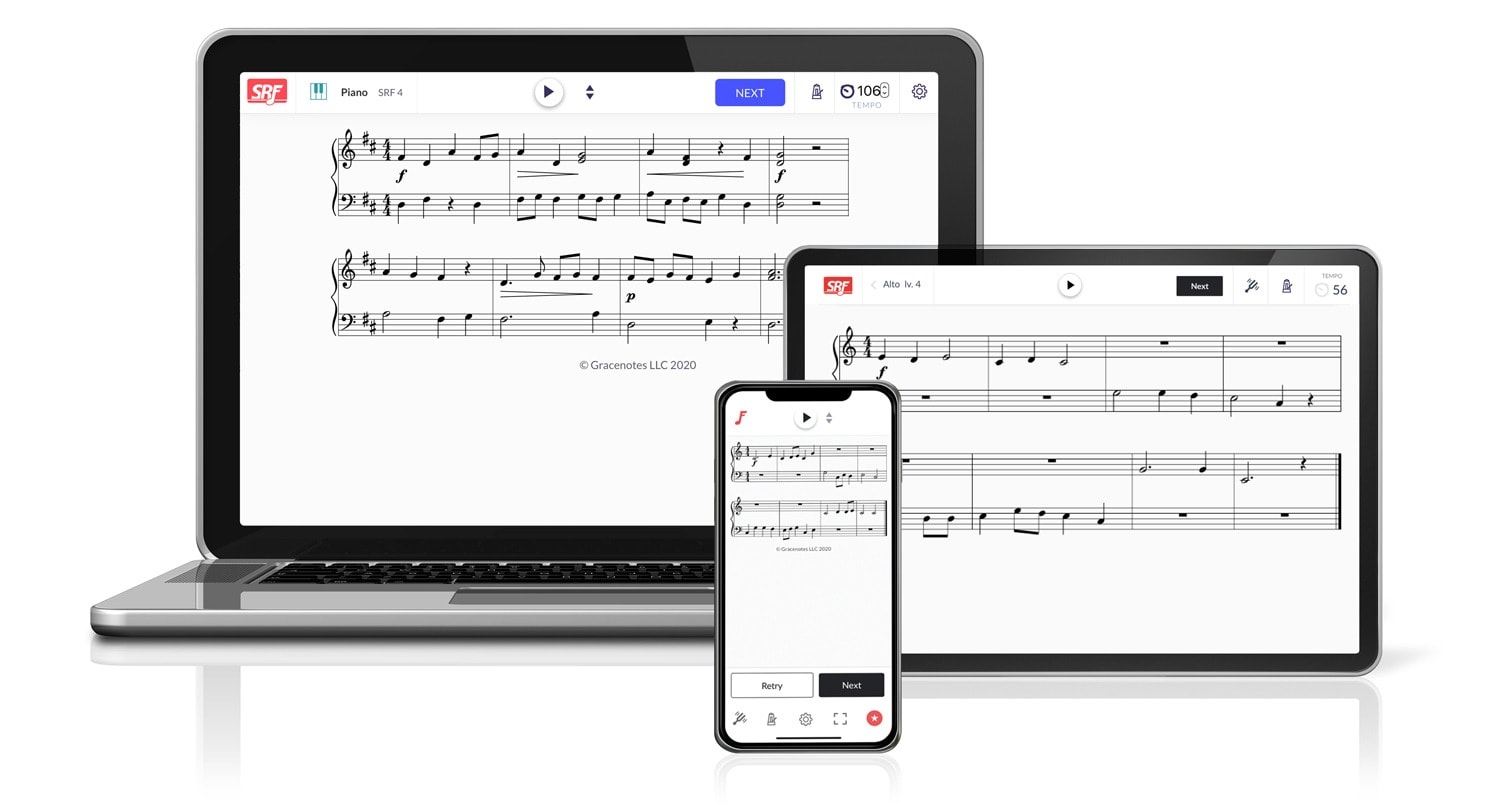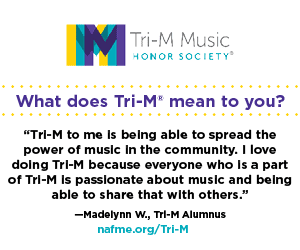/ News Posts / Research Shows Software Improves Students’ Sight-Reading Skills
Research Shows Software Improves Students’ Sight-Reading Skills
By Dr. Amy Bovin, sponsored by MusicFirst
Music reading skills were frequently at the top of my to-do list as a high school band director. Students’ ability to read music directly impacted their success in band, as both individual and ensemble musicians. My published research has shown that “a high level of music sight-reading ability could be crucial for success in the music classroom because those students who are able to read and play music with speed and accuracy may achieve more” (Bovin, 2018, pg. 133). Researchers of previous studies agree that increased sight-reading ability of the individual directly results in increased ability of the overall ensemble (Bovin, 2018; Corum et al., 2007; Gerth, 2015; Gromko, 2004; Hansen, Bernstorf, & Stuber, 2014; Johnson, 1998; Stefanova, 2011). See Figure 1 for a graphic of this concept.
Figure 1– Effects of Sight Reading from the Individual to the Ensemble
As music teachers, many of us struggle with devoting precious ensemble time to sight-reading when we’re focused on preparing for concerts and festivals. Whether virtual or in the classroom, we all desire the most efficient and effective way to improve student sight-reading ability without taking up too much prep or rehearsal time. We also know that even just hearing the phrase “sight-reading” can create anxiety for students, so how can we incorporate this skill into our lessons in a less stressful and more approachable manner for our students?
Good news! Technology has made it easier to include sight-reading in our daily rehearsal plans. Rather than spending time searching for music and making copies available to each student on a daily basis, software and online programs make it possible for teachers to select music in a manner that is less time-consuming and produces less waste. Though there are numerous programs a music teacher can use, I found that SightReadingFactory.com (SRF), available through MusicFirst, was the most efficient way of providing online sight-reading exercises in ensembles and lessons to students of any level, instrument, or ability. This online program has the ability for the user to select options to create customized exercises such as single voice or ensemble, melodic or rhythm only, difficulty, time signature, key signature, articulations, dynamics, and more.
The design of SRF’s music generation algorithm guarantees that the exercises will be different each time, so there will always be something new for the student to read, providing authentic sight-reading practice. In other words, you will never see the exact same exercise twice. SRF’s proprietary algorithm generates new exercises each time based on parameters that teacher or student users select. An endless array of unique melodic and rhythmic combinations are possible.
While using SRF, the user is able to read the music with or without a metronome, enable/disable the cursor, and select a “disappearing measures” feature. Users can work in “free play” mode, or “challenge mode” which provides a countdown timer. SRF provides the option to save examples and convert them into PDFs for easy distribution to students (on paper or electronically), or to use at a later date. When used through MusicFirst, both teachers and students have one-click access to secure SRF accounts.
Through a recent study (Bovin, 2018), I found that SRF was not just easy to use, but that frequent use of the program resulted in an increase in band students’ notational literacy. Three different band groups were used in my eight-week study. The first group used the program at the beginning of all full ensemble rehearsals. The second group used the program at the beginning of all group lesson rehearsals, and the third group did not use the program at all. Statistically significant results were found through use of the program in both ensemble rehearsals and lessons. SRF will provide your students with the practice they need to increase their sight-reading skills, whether you use the program with your full ensemble or in group lessons. (See Bovin, 2018 for full study details and results.)
Using SRF with your students can help achieve curricular objectives and meet the 2014 NAfME Music Standards. Beyond just “Performing” the excerpts, students can “Create” their own examples to use alone or to share with a peer. Students can “Analyze” excerpts created by another, or students can work together as a group to “Select” different options to create an appropriate excerpt for your rehearsal that day. Lessons such as these are not only beneficial for satisfying curricular objectives and meeting standards, but can also be quite enjoyable for the students. Often, my students would approach SRF exercises as a game in which the objective was to get as many notes and musical elements correct as possible (or, in reality, to get more correct than their friends).
In summary, SRF, available through MusicFirst, is the perfect resource to use in any musical ensemble to save time, use less waste, meet curricular objectives, increase music literacy abilities, and add a little fun to your lesson for both you and your students! Who knows? Your students might walk away from your classroom actually . . . gasp . . . enjoying sight-reading!
References
Bovin, A. J. (2018). The effects of frequent use of a web-based sight-reading software on eighth graders’ music notational literacy. Journal of Music, Technology and Education, 11(2), 131-147.
Corum, J. A., Kepler, D. E., Mattson, T. J., & Okerstrom, J. L. (2007). An examination of secondary literacy practices: An evaluation tool for school leaders to improve literacy instruction and student achievement (Doctoral Dissertation). Retrieved from ProQuest Dissertations & Theses database. (UMI No. 304817834)
Gerth, J. (2015). A new wave in music sight reading: Sightreadingfactory.com. Music Ed Magic. Retrieved from http://www.MusicEdMagic.com
Gromko, J. E. (2005). The effect of music instruction on phonemic awareness in beginning readers. Journal of Research in Music Education, 53, 199–209.
Hansen, D., Bernstorf, E., & Stuber, M. (2014). The music and literacy connection. Lanham, Maryland: Rowman & Littlefield.
Johnson, A. (1998). Using literacy learning theories to facilitate sight-reading and music learning. The Choral Journal, 39 (1), 37-39.
Stefanova, M. (2011). Developing critical thinking and assessment in music classrooms. American String Teacher, 61(2), 29-31. Retrieved from http://search.proquest.com/docview/881982647?accountid=11308
About the author:
 Dr. Amy Bovin has been a prominent music educator for over a decade, teaching bands at the secondary and collegiate levels, presenting at conferences and workshops across the country, conducting ensembles around the globe, and completing research on the topics of music literacy using technology and gendered experiences in instrumental music.
Dr. Amy Bovin has been a prominent music educator for over a decade, teaching bands at the secondary and collegiate levels, presenting at conferences and workshops across the country, conducting ensembles around the globe, and completing research on the topics of music literacy using technology and gendered experiences in instrumental music.
Did this blog spur new ideas for your music program? Share them on Amplify! Interested in reprinting this article? Please review the reprint guidelines.
The National Association for Music Education (NAfME) provides a number of forums for the sharing of information and opinion, including blogs and postings on our website, articles and columns in our magazines and journals, and postings to our Amplify member portal. Unless specifically noted, the views expressed in these media do not necessarily represent the policy or views of the Association, its officers, or its employees.
Published Date
January 14, 2021
Category
- Technology
Copyright
January 14, 2021. © National Association for Music Education (NAfME.org)






